Forest Green
ACCESS: Above Top Secret
- Joined
- 11 June 2019
- Messages
- 9,421
- Reaction score
- 17,163
What are these pictures showing?
What are these pictures showing?
Not all fins are visible until after RV is deployed.And has fins for guidance.View attachment 699579
They show that the Dagger in this screenshot has a detachable warhead, but the Iskander in this screenshot does not.What are these pictures showing?
We're really talking about the RV not the warhead. So does the RV steer via deployable fins, flaps or by thrust in order to guide?They show that the Dagger in this screenshot has a detachable warhead, but the Iskander in this screenshot does not.

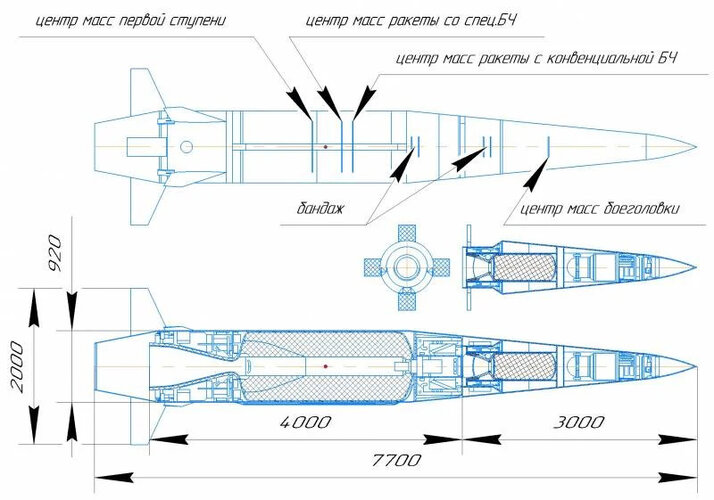
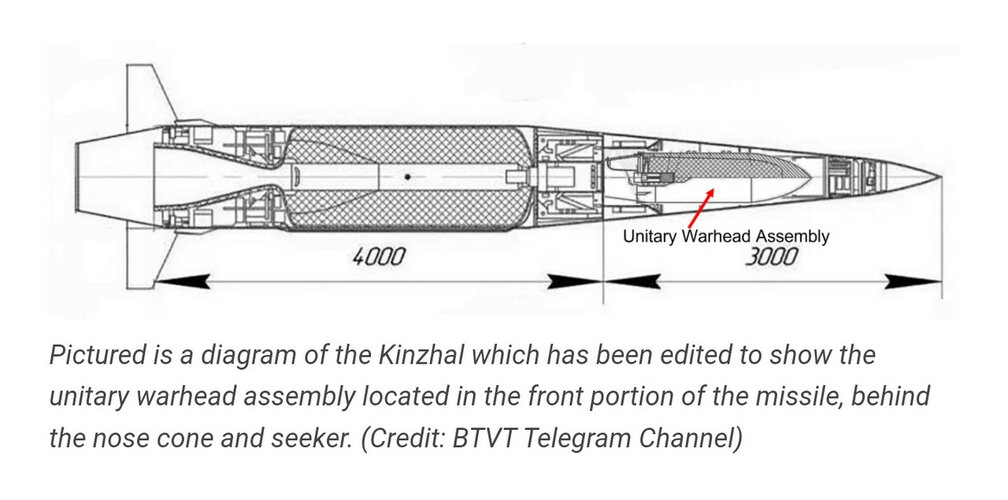
Very different shape for the 700kg Iskander warhead. it seems.
I think you can actually see the folded flaps in the last drawing.There are a few of these internal arrangement diagrams floating around the interwebs, do we know if any of them are any more than educated guesswork?
View attachment 699614
View attachment 699615
EDIT: Zooming in on the second drawing shows that the 'unitary warhead assembly' has pretty clearly been added at a later date to a copy of the internal arrangement drawing above (in blue), and so is probably even less reliable than that drawing.
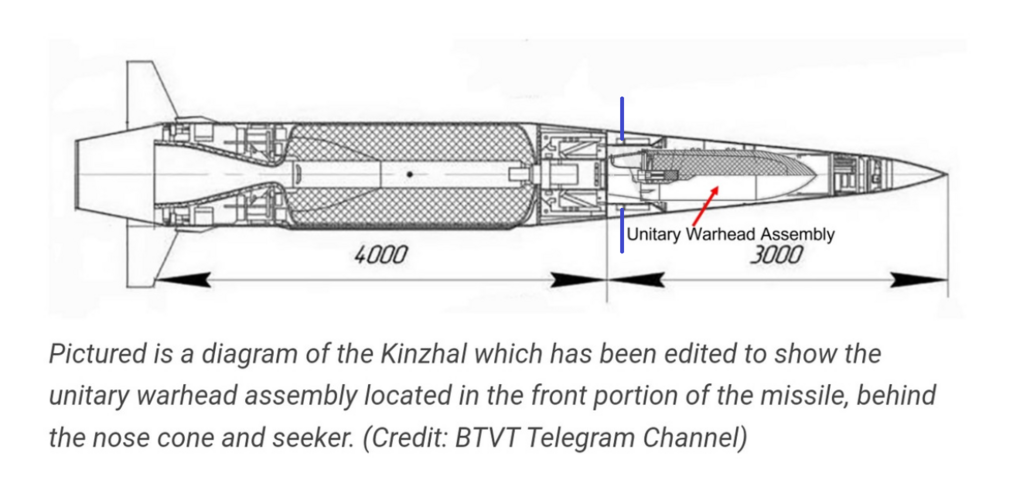
Yeah you can, but only because the 'unitary warhead' section of the drawing has been dropped on top of the same section from the drawing above (in blue). You can see whoever did it didn't bother moving or removing any other lines, they just dropped that bit in on top. That part of the picture even uses a different line thickness to the rest of the diagram. They even drew over the mechanicals that drive the flaps.I think you can actually see the folded flaps in the last drawing.There are a few of these internal arrangement diagrams floating around the interwebs, do we know if any of them are any more than educated guesswork?
View attachment 699614
View attachment 699615
EDIT: Zooming in on the second drawing shows that the 'unitary warhead assembly' has pretty clearly been added at a later date to a copy of the internal arrangement drawing above (in blue), and so is probably even less reliable than that drawing.
View attachment 699656
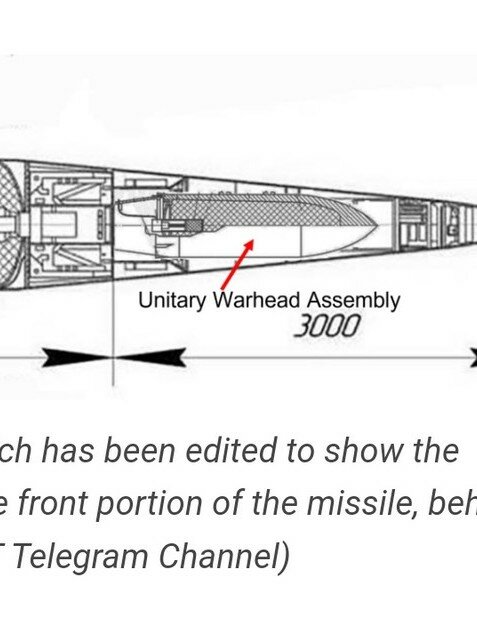
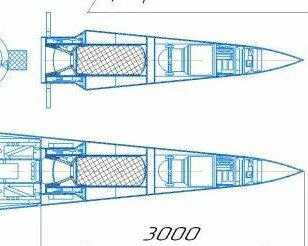
There are a few of these internal arrangement diagrams floating around the interwebs, do we know if any of them are any more than educated guesswork?
View attachment 699614
View attachment 699615
EDIT: Zooming in on the second drawing shows that the 'unitary warhead assembly' has pretty clearly been added at a later date to a copy of the internal arrangement drawing above (in blue), and so is probably even less reliable than that drawing.
There are a few of these internal arrangement diagrams floating around the interwebs, do we know if any of them are any more than educated guesswork?
View attachment 699614
View attachment 699615
EDIT: Zooming in on the second drawing shows that the 'unitary warhead assembly' has pretty clearly been added at a later date to a copy of the internal arrangement drawing above (in blue), and so is probably even less reliable than that drawing.
" even less reliable ? " We know the location of the warhead that is behind the radar.
I have heard it said that a stick of butter actually has more energy density than a stick of C4 of similar size—just inert.My dad used to use cubes of C4 to boil his coffee in Nam.
It does say it's been edited to show the unitary warhead warhead though. But fact is, it matches the one found in the Stavropol Kinzhal crash site anyway, and that's the only thing we know is really of and from the Kinzhal. Or were you talking about the blue line drawings?Yeah you can, but only because the 'unitary warhead' section of the drawing has been dropped on top of the same section from the drawing above (in blue). You can see whoever did it didn't bother moving or removing any other lines, they just dropped that bit in on top. That part of the picture even uses a different line thickness to the rest of the diagram. They even drew over the mechanicals that drive the flaps.
That's more likely the Iskander given the different unitary warhead shape (top drawing) that matches the one found in Syria (below).Another set of diagrams, sadly in potato quality. The middle one appears to be the cassette warhead type Paralay mentioned. Again, don't know how accurate or not. Probably not.
View attachment 699696
I'm wondering which came first, the edited drawing or the crashed missile?It does say it's been edited to show the unitary warhead warhead though. But fact is, it matches the one found in the Stavropol Kinzhal crash site anyway, and that's the only thing we know is really of and from the Kinzhal.
Probably.I'm wondering which came first, the edited drawing or the crashed missile?It does say it's been edited to show the unitary warhead warhead though. But fact is, it matches the one found in the Stavropol Kinzhal crash site anyway, and that's the only thing we know is really of and from the Kinzhal.
Also, that Stavropol crash seems weird to me. Did it land horizontally?
The Stavropol crash was a Kinzhal missile that failed on launch and crashed in Russia.I'm wondering which came first, the edited drawing or the crashed missile?
Also, that Stavropol crash seems weird to me. Did it land horizontally?
Neither it has 'Kh-47M2' designation
It's NATO designation is the AS-24 Killjoy and the missile it was derived from is the SS-26 Stone.
So the AS-24 has a separable MARV?
The 9M723 Ballistic Missile
9M723 SRBM is 7.3 meters long, 0.92 meters in diameter, and have a launch weight of 3,800 kilograms.6 The missiles possesses a maximum range of 500 km and carries payloads between 480 and 700 kg. The export variant, the 9M720 has a reduced range of 280 km while carrying a 480 kg payload.7
These missiles fly on a depressed trajectory and can maneuver up to 30g in flight. Additionally, the 9M723 is reported to have a separating warhead which can independently maneuver in the terminal stage. Using a combination of inertial, GLONASS, and radar terrain correlation guidance, the missile can strike targets within a circular error probable (CEP) of 2-5 meters. The 9M720 export model employs inertial guidance for midcourse flight and electrooptical terminal guidance to achieve accuracies between 5 and 10 m CEP. Several units may also be fitted with a digital scene matching area correlation (DSMAC) terminal guidance system, which was first tested in 2011 and entered service in 2012.8

 missilethreat.csis.org
missilethreat.csis.org
The Iskander has several different conventional warheads, including a cluster munitions warhead, a fuel–air explosive enhanced-blast warhead, a high-explosive fragmentation warhead, an earth penetrator for bunker busting and an electromagnetic pulse device for anti-radar missions. The missile can also carry nuclear warheads.
Not according to picture on previous page.No sorry, don't know. Won't muddy the waters.
EDIT: Iskander-M might though:
Missed this.Not according to picture on previous page.No sorry, don't know. Won't muddy the waters.
EDIT: Iskander-M might though:
Sorry Forrest, I rely on the notifications system to work out if someone has replied to me and I'm only 'watching' a couple of threads.
A simple calculation scheme gives RCS=0.058 m2
How much is it in decibels?
Does Kinzhal even use liquid propellant?
Does Kinzhal even use liquid propellant?
Another TASS trustful source told you so?missile did not reach a target.
